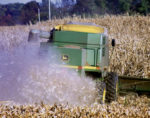Advertise Follow Us
Articles Tagged with ''insects''
Continuous Corn Residue Tough But Manageable
Some no-tillers are learning the ropes and suppliers are looking to meet their needs as rising prices lure growers toward corn on corn.
Read More
No-Till “Shines” When The Sun Swipes Valuable Moisture
Moisture conservation may be the key to reducing disease since moisture-stressed wheat is more susceptible to infection.
Read More
Get After Those Troublesome No-Till Corn Insects!
A review of proven insect-control measures offers new ideas for combatting no-till pests.
Read More
The No-Till Answer Man!
As part of this continuing series, an Indiana farmer tackles your most frequently asked no-tilling questions.
Read More
Should You No-Till Soybeans Before No-Tilling Corn?
University of Nebraska research shows a yield advantage of anywhere from 5 to 13 bushels per acre.
Read More







